Les années 50-60
One of this year’s biggest watch-world stories is the 60th anniversary of the iconic Omega Speedmaster. In this series of feature articles, we explore some of the collection’s milestones, decade by decade. This week, we look at models starting with the very first Speedmaster in 1957, up to the legendary Mark II and Alaska I prototype from 1969.
1957: The “Broad Arrow”
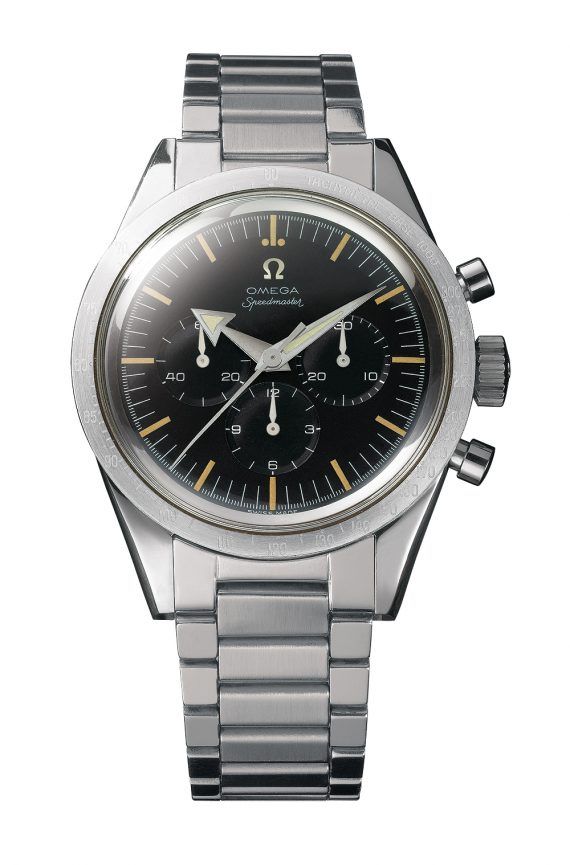
Omega Speedmaster “Broad Arrow” (1957)
The very first Omega Speedmaster was nicknamed the “Broad Arrow” due to its distinctive hands. It was also the first chronograph wristwatch in the world with its tachymeter scale on the bezel rather than printed on the dial — a feature designed with race car drivers in mind. Perhaps the most coveted of all the Speedmasters, it heralded many other collectible models to come.
1959: The First Omega in Space
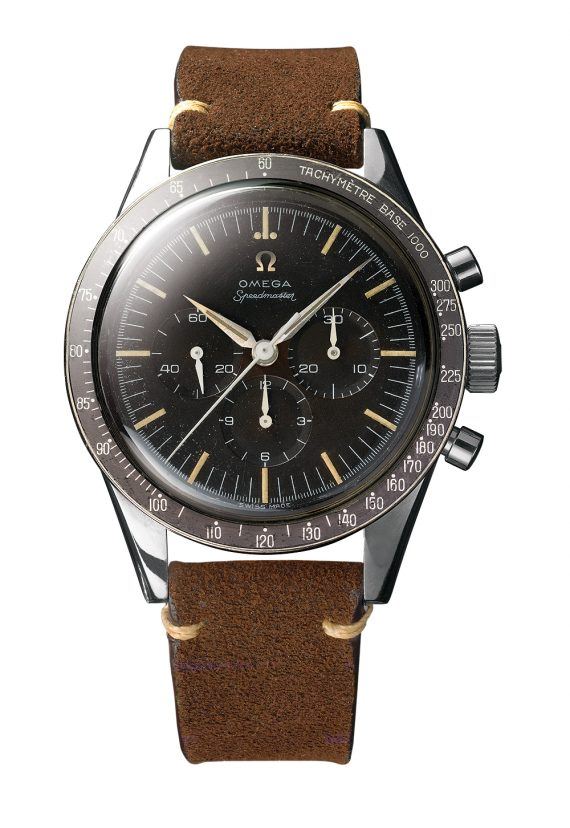
Omega Speedmaster worn by Walter Schirra (1959)
The second version of the Speedmaster is distinguished from the original “Broad Arrow” by its use of a black aluminum bezel, its “lollipop” seconds hand for Air Force orders, and its “Alpha”-style hour and minute hands. The model became the first Omega watch worn in space, on the wrist of astronaut Walter Schirra, on October 3, 1962. Schirra chose the Speedmaster as his personal watch on the Sigma 7 mission of the Mercury program. The Speedmaster’s space legacy had begun.
1963: The Third Generation, NASA-Tested and -Qualified
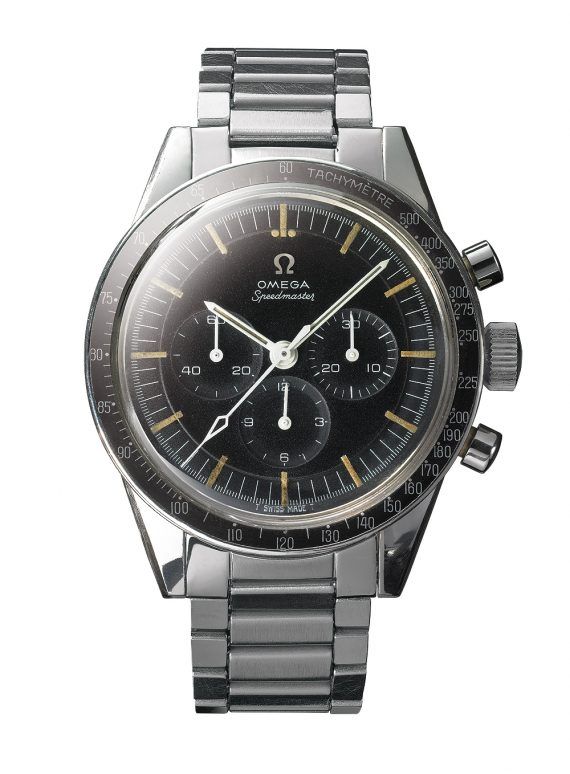
Omega Speedmaster – tested and qualified by NASA (1963)
The third-generation Omega Speedmaster was the first watch to pass NASA’s rigorous testing for flight qualification. A number of other watch brands submitted timepieces for testing, but only the Speedmaster survived. This watch was worn by astronauts on the Gemini and Apollo missions, and would also become, interestingly, the last one worn on the moon in 1972.
1964: A.C.P. (Automovil Club Peruano)
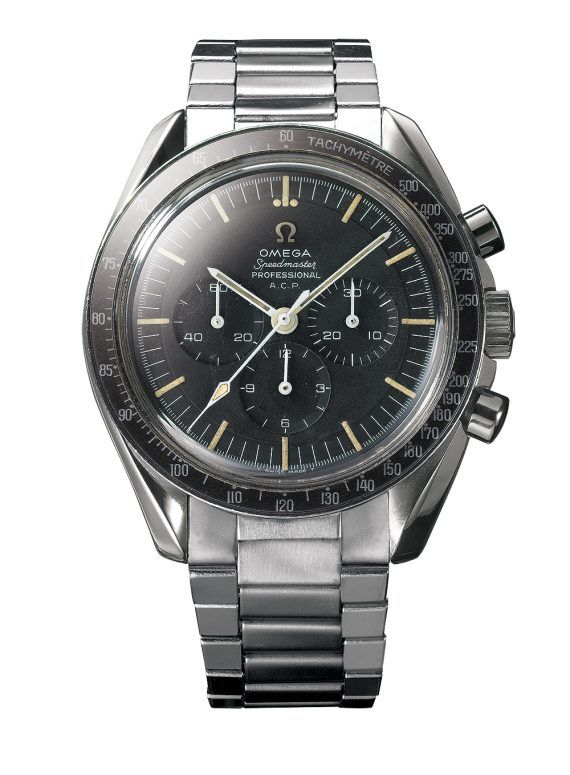
Omega Speedmaster A.C.P. (1964)
Hearkening back to the Speedmaster’s origins as an auto racing watch, this rare model was specially ordered by the Automovil Club Peruano, based in Lima, Peru. The tachymeter scale on the bezel was intended for timing laps on the racetrack. With an order of just 50 pieces, and identified by the A.C.P lettering on the dial, this model is extremely hard to find and thus very prized among collectors.
1965: The First Watch on the Moon
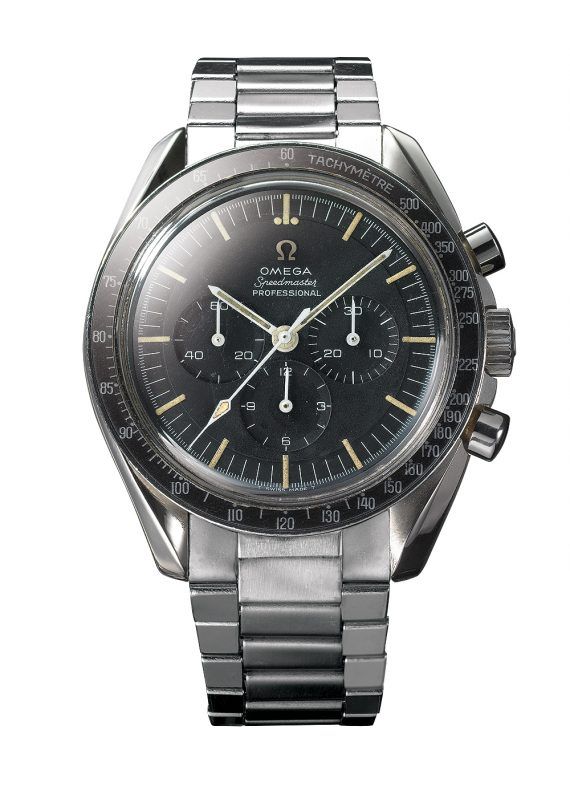
Omega Speedmaster “Moonwatch” (1965)
When Neil Armstrong and Buzz Aldrin stepped onto the lunar surface in 1969, this Speedmaster model became the first watch ever worn on the moon. It has also become the watch that has served on the most lunar missions. The watch was the first Speedmaster with the now-recognizable, asymmetrical case, a design that was meant to provide added protection for the crown and pushers. The word “Professional” was also added to the dial for the first time in this model.
1968: The Modern Moonwatch

Omega Speedmaster Moonwatch (1968)
Launched in 1968 with the new Caliber 861, this model marked a major turning point in the history of the Speedmaster. Not only was it the debut of the now-classic new movement, but it was also the first, from 1970 onwards, to include the words “FLIGHT-QUALIFIED BY NASA FOR ALL MANNED SPACE MISSIONS” and “THE FIRST WATCH WORN ON THE MOON.”
1968: Speedmaster with Racing Dial
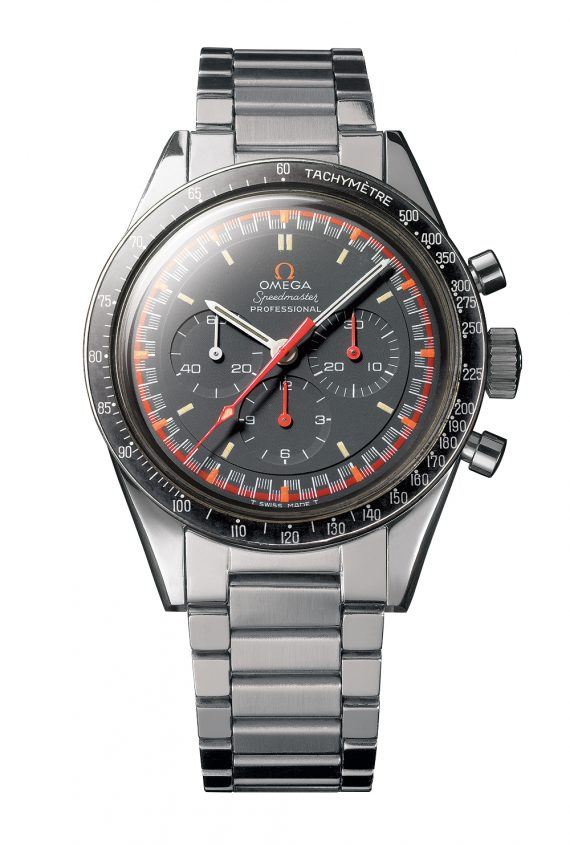
Omega Speedmaster with Racing Dial (1968)
The origins of the rare Racing Dial model are still shrouded in mystery, but it is generally accepted that the bicolor minute markers and orange hands and logo were created to make the dial’s chronograph displays easier to read. This particular model has inspired subsequent editions throughout the years, including a limited-edition series which was released in Japan in 2014.
1968: The “Ultraman” Watch
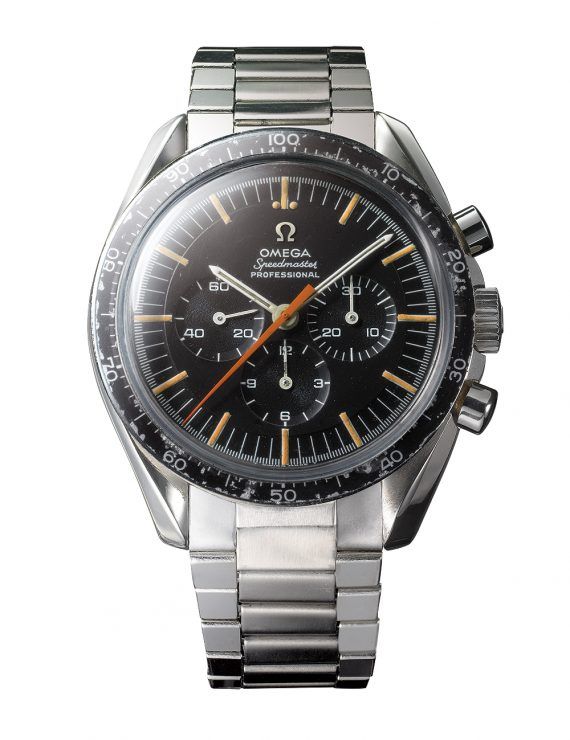
Omega Speedmaster “Ultraman” (1968)
Speaking of Japan, this rare piece, distinguished by its orange seconds hand, is renowned for appearing in the Japanese science fiction TV show “The Return of Ultraman” in 1971. The creator of the Ultraman series, Eiji Tsuburaya, was known for including interesting watches in his productions, and this very collectible Speedmaster is no exception. It is unknown how many genuine pieces still exist.
1969: The Gold Commemorative Edition
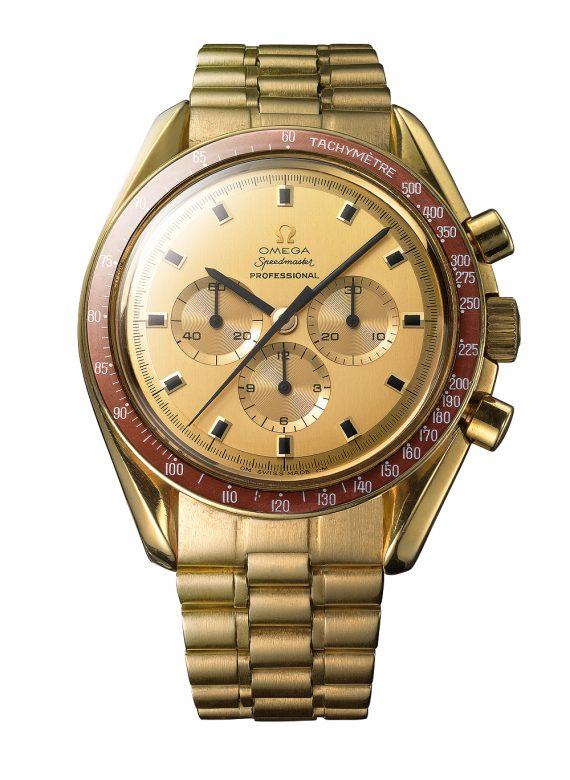
Omega Speedmaster Commemorative Edition (1969)
This was the first Speedmaster in 18k gold, created in a numbered edition and bearing a distinctive burgundy bezel. The first watches in this series were presented to 19 astronauts during a gala dinner in Houston, Texas on November 25, 1969, to celebrate the Apollo 11 moon landing. Three watches were also awarded posthumously to the three crew members of the Apollo I mission – Virgil Grissom, Ed White, and Roger Chaffee.
1969: The Speedmaster Mark II
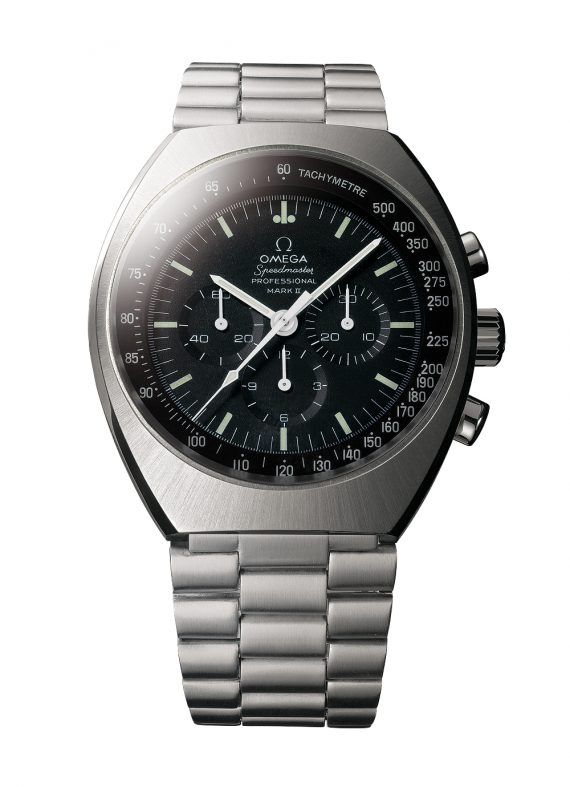
Omega Speedmaster Mark II (1969)
The Speedmaster Mark II signaled the first redesign of Omega’s popular chronograph. Created in 1969, it extended the Speedmaster line with a brand new look and was available in stainless steel, 18K gold, or gold-capped versions with various dial and timing scale combinations. The Mark II, with its barrel-shaped case and enhanced readability, was also the first Speedmaster that did not use a hesalite crystal. A modernized version of the watch debuted in 2014.
1969: The Alaska I Prototype
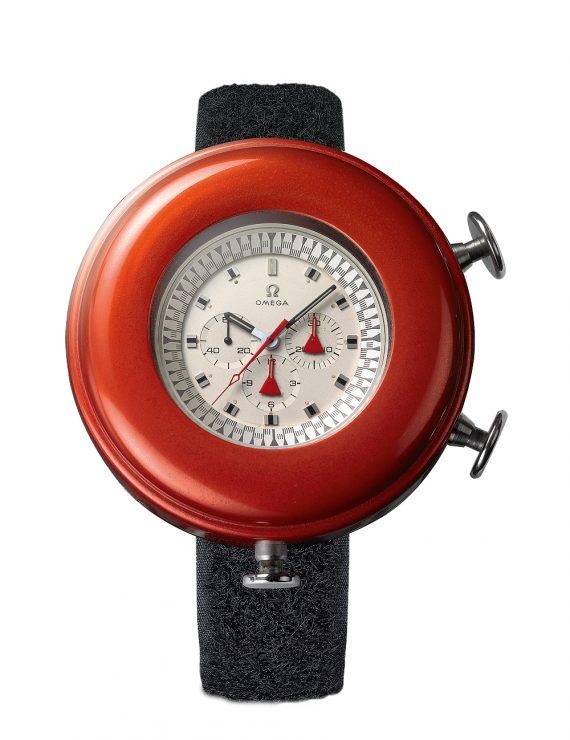
Omega Speedmaster Alaska I (1969)
“Alaska” was Omega’s chosen codename for all of its top-secret projects that involved NASA. To meet the demands of the extreme temperatures of space, the “Alaska I” prototype had a removable anodized aluminum outer case — referred to as a “thermal shield” — and a pure titanium inner case, making it the first wristwatch in the world to be cased in pure titanium. The white dial was added to better reflect the heat of the sun.
Les années 70
1971: Mark III, Omega’s first self-winding chronograph
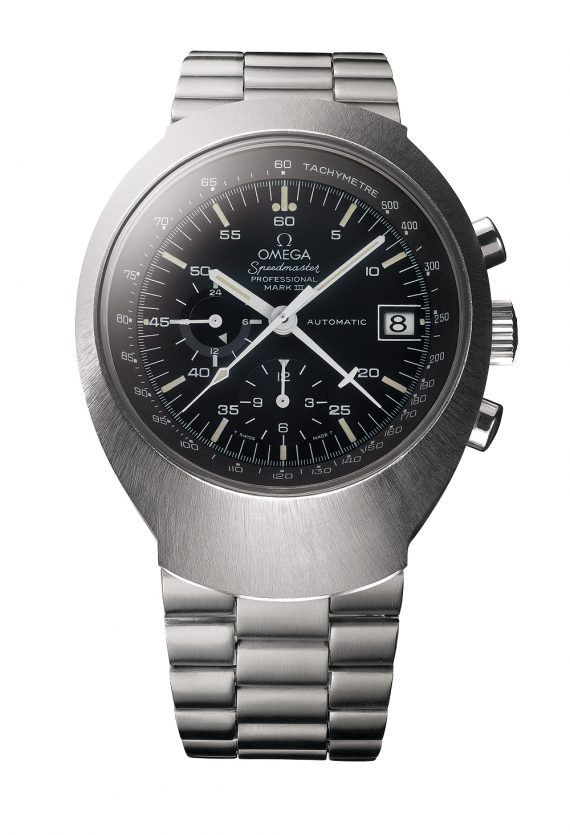
Omega Speedmaster Mark III (1971)
Launched in 1971, the Speedmaster Mark III, with its “pilot” case, was Omega’s first self-winding chronograph, containing the new Caliber 1040, a milestone for the brand. In an advertisement for the watch in 1972, Omega famously stated, “After six landings on the moon, there was only one thing we could teach the Speedmaster. To wind itself.” The Speedmaster Mark III’s other interesting features include the cross-shaped 60 minute chronograph hand and its unique 24-hour day/night indicator at 9 o’clock.
1972: Alaska II (prototype), pursuing the perfect “space watch”
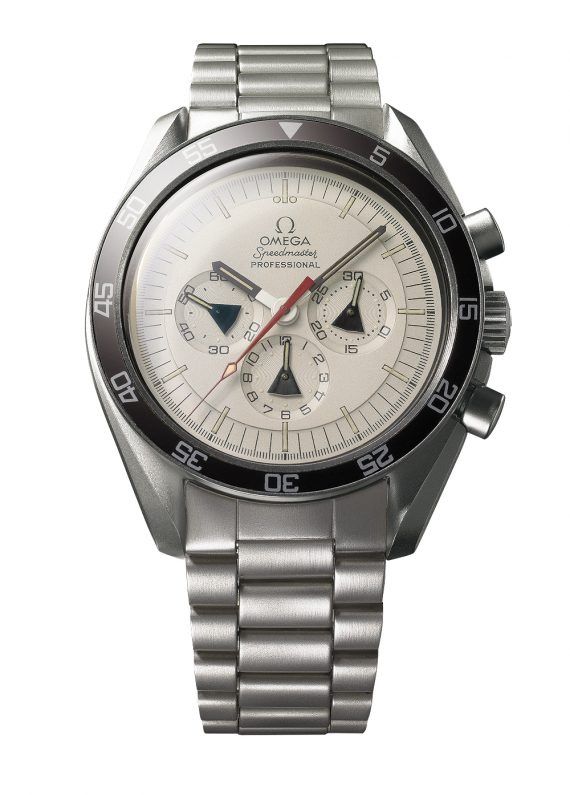
Omega Speedmaster Alaska II (1972)
Continuing its secret project to build the perfect space watch for NASA, which started with 1969’s Alaska I, Omega produced another prototype, this time in a Moonwatch style that retained some of the original features of the Alaska I model, including the large red heat shield. The watch’s white dial, engineered to better reflect the heat of the sun, was also retained. Other updates included the rocket-shaped subdial hands, luminous markers and radial numerals on the subdials, and the 0 – 60 numbered bezel.
1973: Speedsonic, the first electronic Speedmaster
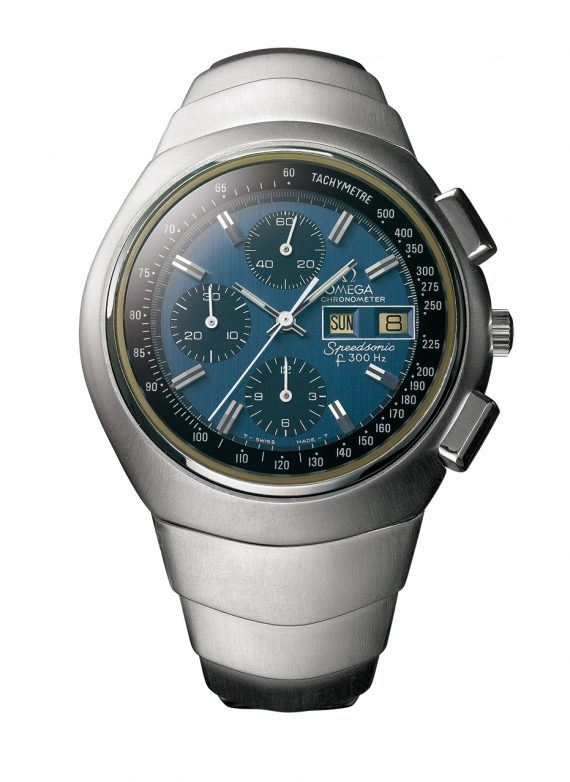
Omega Speedmaster Speedsonic (1973)
This model is nicknamed the “Lobster” due to the unusual shape of its bracelet, which resembles the tail of a crustacean. With the desire for electronic watches growing during this period, Omega created the Speedsonic was with an innovative electromechanical movement to meet demands for greater precision and reliability. Interestingly, the crown was deliberately made smaller in size, to emphasize the reduced need the wearer would have to manually change the time or date.
1973: Speedmaster 125, celebrating 125 years of Omega
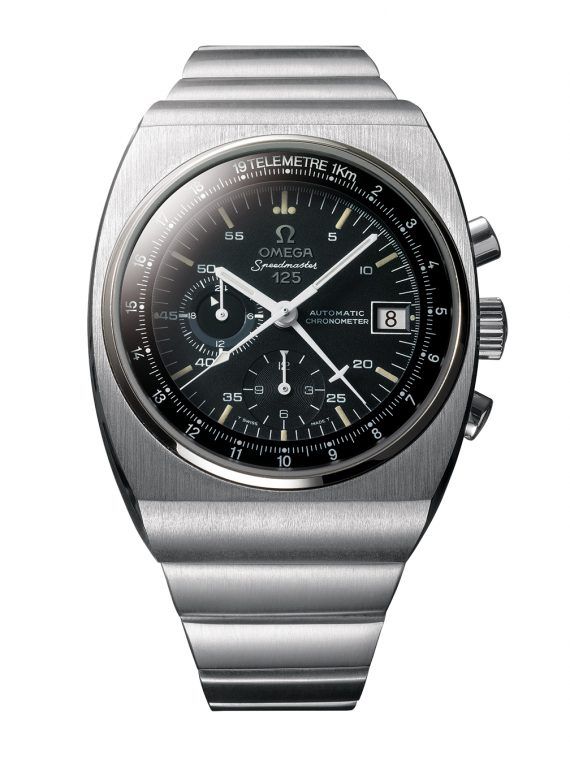
Omega Speedmaster 125 (1973)
This model — the world’s first automatic chronograph to receive an official Chronometer Certification — was released to celebrate the founding of the Omega brand in 1848. Only 2,000 pieces were produced to mark the occasion. The watch was later worn by Russian cosmonaut Vladimir Dzhanibekov on a 1978 mission during which he spent a total of 145 days and 16 hours in space.
1975: Apollo-Soyuz, celebrating the American-Soviet mission
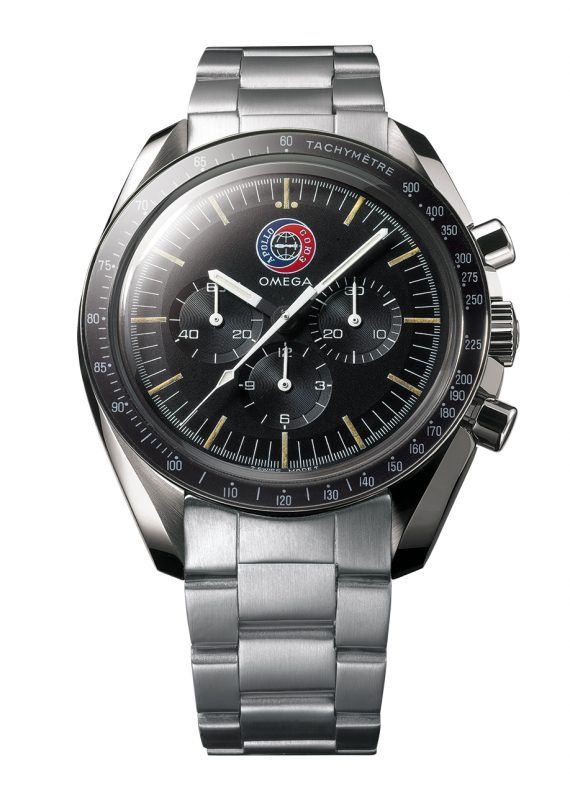
Omega Speedmaster Apollo Soyuz (1975)
In 1975, Russian cosmonauts and American astronauts wore Omega Speedmasters during a historic meeting in space that signaled the beginning of the end of the Cold War. Made in a limited edition of 500 pieces to mark this historic American-Soviet space rendezvous, this watch was the first of the “Patch” Speedmasters. It has the mission patch at 12 o’clock, in place of the Omega logo, as well as longer markers on the dial and wider chronograph pushers.
1978: Alaska III, built for the Space Shuttle
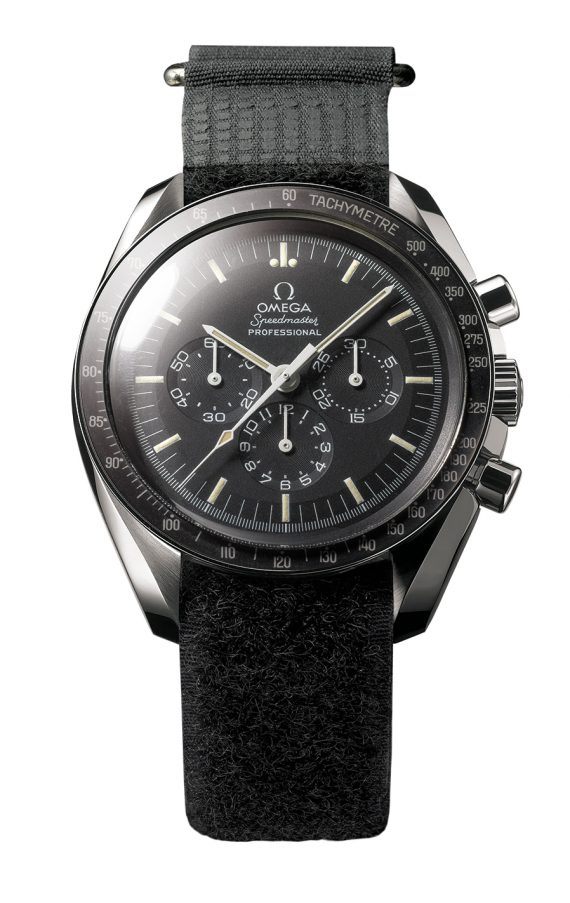
Omega Speedmaster Alaska III (1978)
When Omega began work on the “Alaska III” project, its aim was to adapt the classic Moonwatch to include nonreflective surfaces and a dial that was easier to read than its predecessors’. The resulting watch featured a brushed stainless steel case and large, radial numerals on the subdials. The first batch of 56 pieces was delivered to NASA, which used them on board the Space Shuttle in the 1980s; a second batch soon followed.
1979: Alaska IV, quartz prototype for NASA
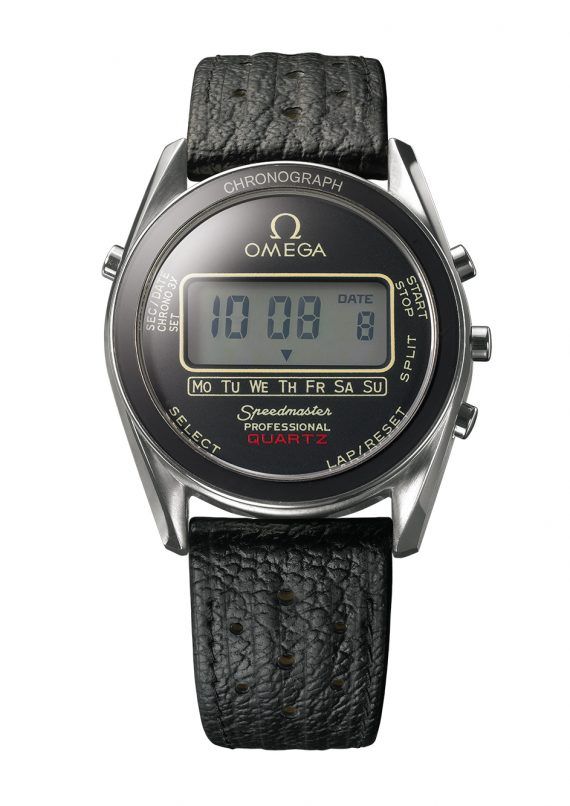
Omega Speedmaster Alaska IV (1979)
When the Omega Speedmaster briefly went digital, during the heyday of quartz digital watches, this prototype was created for the astronauts at NASA based on the commercial models. It had all the same functions but also included a BETA light system that could illuminate the display without using a typical lightbulb. 12 pieces were sent to NASA astronauts, who tested the watch in training and on the Space Shuttle. Ultimately, they chose not to adopt the watch.
Les années 80
1980: Omega Speedmaster Apollo 11, Omega’s first sapphire crystal caseback
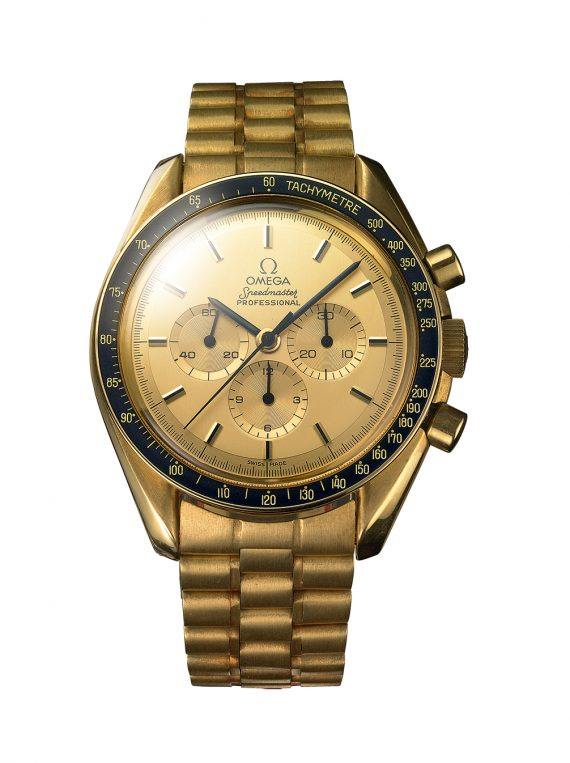
Omega Speedmaster Apollo 11 (1980)
Launched to celebrate the 1969 Apollo 11 mission — in which the Omega Speedmaster became the first watch worn on the moon — this yellow-gold model was the first to be outfitted with the 861L caliber. It was also the first Omega timepiece to put its caliber on display, through a glazed sapphire caseback window. The watch was produced in a very small, numbered series of around 300 pieces; the “L” suffix at the end of the Caliber number “861” indicated that it was the “Luxury” version of that movement, with a higher level of decoration than was normally afforded.
1983: The first bi-color Speedmaster
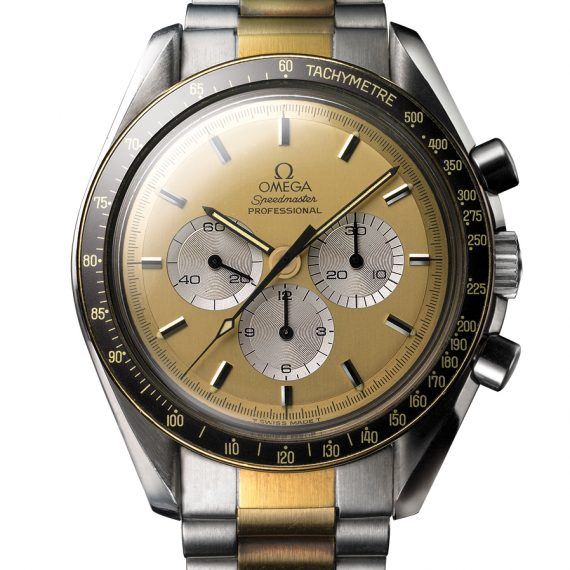
Omega Speedmaster Bicolor (1983)
The first Speedmaster model with a two-tone design, this 1983 model combined a steel case with a golden dial, silvered chronograph subdials, and a bracelet made from steel and 14K gold. It is unknown exactly how many of this reference that Omega produced, but very few are known to still exist.
1985: The first Speedmaster moon-phase model
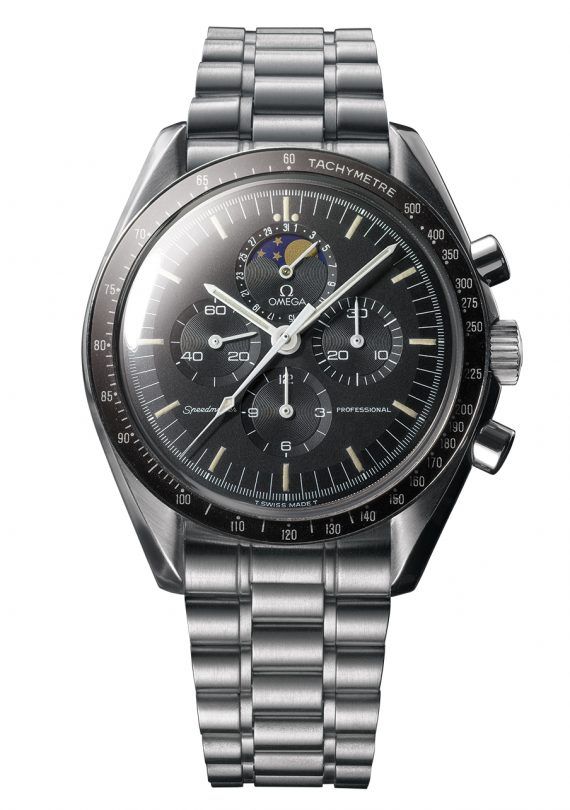
Omega Speedmaster “Speedymoon” (1985)
“Twenty years after the Speedmaster began preparing to go to the moon,” Omega states in its press materials on the Speedmaster’s 60-year history, “the moon came to the Speedmaster.” The watch, nicknamed “Speedymoon,” was produced in a series of 1,300 pieces and was the first in the iconic series to include a moon-phase complication, whose disk was adorned with a painted moon and stars. There are even some rare Speedymoon models that feature a painted face on the moon’s surface.
1987: Speedmaster Automatic
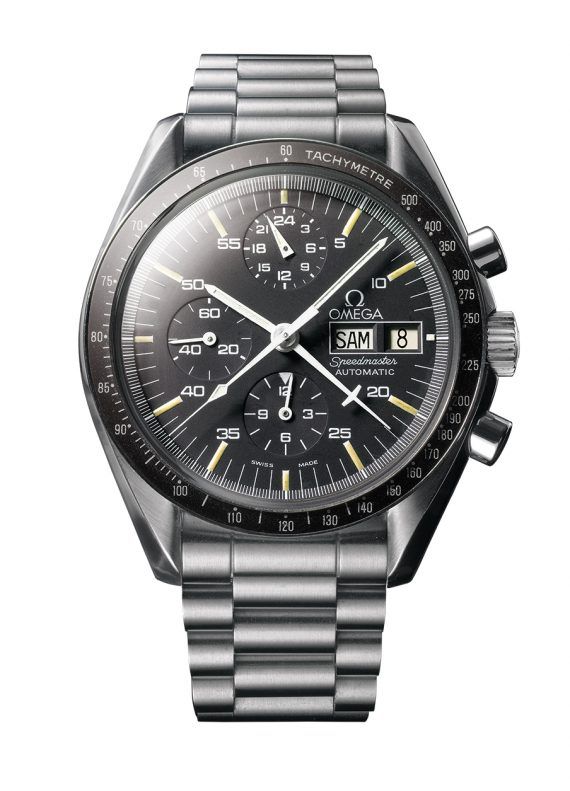
Omega Speedmaster Automatic (1987)
Considered by many collectors as the “Holy Grail” of vintage Speedmasters, this was the first watch in the collection that combined an automatic movement with a “Moonwatch” case. Omega only produced the watch for two years, making it an extremely rare piece, sought out obsessively by the Speedy’s legions of fans and collectors. Design-wise, this watch’s case is slightly thicker than those of other Speedmasters to accommodate the automatic movement, and the chrono pushers and crown are closer fitting than those on the classic Moonwatch.
1987: A Speedmaster made especially for Italy
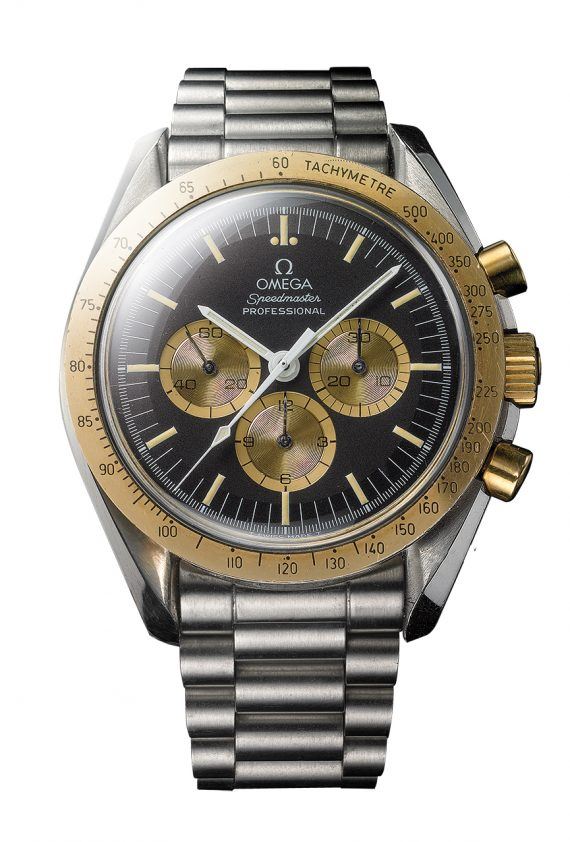
Omega Speedmaster “Italy” (1987)
Limited to only 500 pieces, this timepiece was created for the Italian market. It featured a black dial with golden subdials, a yellow-gold bezel and yellow gold-plated crown and pushers. And it could be considered a tribute to the Speedmaster’s interesting but little-known historical connection with Italy. The Seahorse medallion that appears on the casebacks of many Speedmaster and Seamaster models was, in fact, inspired by the Seahorse emblems found on the sides of gondolas in Venice.
Les années 90
1991: Perpetual Calendar for Switzerland’s 700th Anniversary

Omega Speedmaster Perpetual Calendar (1991)
This Speedmaster model, limited to just 50 pieces, celebrated the 700th anniversary of Switzerland — but for whatever reason was released exclusively to the Japanese market. In addition to the chronograph function common to the Speedmaster series, this rare timepiece — often regarded as the most complicated watch Omega has ever produced in a series — also includes a moon-phase indication and a perpetual calendar accurate to the year 2100.
1992: Rare Hand-Crafted Skeleton Limited Edition

Omega Speedmaster Skeleton (1992)
This watch — and its skeletonized movement, visible through the front dial and a clear caseback — was limited to only 50 pieces. It was intended as a special tribute to the 50th anniversary of Omega’s 27 CHRO C12 project, launched in 1942, which led to the creation of Calibre 321 — the movement used in the very first Speedmaster.
1992: First COSC-Certified Manual-Wound Speedmaster

Omega Speedmaster Jubilee (1992)
Another very limited tribute piece released in the anniversary year of the 27 CHRO C12 project, the so-called Omega “Jubilee 27 CHRO C12” model was the first COSC-certified, manual-wound Speedmaster watch, only 50 pieces of which were ever made.
1995: Apollo 13

Omega Speedmaster Apollo 13 (1995)
An Omega Speedmaster played a life-saving role aboard the Apollo 13 space mission in 1970, helping the astronauts return safely to Earth. This model, commemorating the 25th anniversary of that mission, is a favorite among collectors, as it was the first in what would become a long series of Mission models that followed. An Apollo 13 badge appears on the dial of the watch, which was limited to 999 pieces.
1995: 365 Days on MIR Space Station

Omega Speedmaster MIR 365 Days (1995)
In 1990, 10 standard Speedmaster Moonwatches were kept aboard the orbiting MIR Space Station for 90 days to test the effects of zero gravity on the watch. Two years later, a second series spent 365 days on the station in a further experiment. Twenty-eight of these history-making watches were sold in 1995. The inscription “365 DAYS ON BOARD SPACE STATION MIR, JULY 1993 – JULY 1994” appear on the solid caseback.
1996: “Racing,” Launched by Michael Schumacher

Omega Speedmaster Racing Schumacher (1996)
Notable for its “younger” aesthetics and produced in both red and yellow versions, this Speedmaster with a vintage racing-style minute track was launched in a collaboration with racing legend Michael Schumacher, who became an Omega “brand ambassador” in 1996. The watch was presented in a rubber presentation box that resembled the tires of Formula One cars and featured Schumacher’s signature in white.
1997: Inspired by the 1957 Original

Omega Speedmaster Relaunch (1997)
With the exact same dial, bezel, hands, and logo as the famous “Broad Arrow” original from 1957, this watch — sometimes to referred to as the “Replica” — was the first to be included in the 1997 “Missions” collection, which marked the 40th anniversary of the Speedmaster. Along with this watch, the set contained 22 other Speedmasters, each with a different mission patch on the dial.
1997: “The Golden Panda”

Omega Speedmaster “The Golden Panda” 3690.30.01 (1997)
Another timepiece created specifically for the Japanese market, the so-called “Golden Panda” Speedmaster was limited to only 40 pieces. Thanks to the silvery-white dial and black minute scale and subdials, the watch resembled the face of a panda, which gave it its memorable nickname. This distinctive look, its rarity, and its gold case have made this watch a valuable collectors’ item.
1997: 40 Years of the Speedmaster

Omega Speedmaster 40th Anniversary (1997)
Another tribute piece to the Speedmaster’s 40th anniversary, this model released in 1997 featured a cream-colored dial and a sapphire crystal over the dial – an unusual feature for the time. Limited to 500 pieces and exclusive to Italy, it was also one of the first models to have its hands and dial coated in LumiNova.
1998: Omega X-33

Omega Speedmaster X33 (1998)
Known as the “Mars Watch,” the futiristic-looking X-33 was designed for the possibility of man landing on the red planet. It is the product of five years’ collaborative development between Omega and the world’s major space agencies, as well as the USN “Blue Angels” and the USAF “Thunderbirds.” This model was worn aboard NASA’s space shuttles and Russia’s MIR Space Station.
1999: Apollo 11

Omega Speedmaster Apollo 11 (1999)
Launched in 1999 to mark the 30th anniversary of Apollo 11, this model was the second Speedmaster Professional to include a moon-phase indication and the first Speedmaster with this complication to be created in gold — or, in fact, any metal other than stainless steel. This white-gold timepiece featured a silver dial and was available exclusively on a leather strap with a white-gold buckle.


